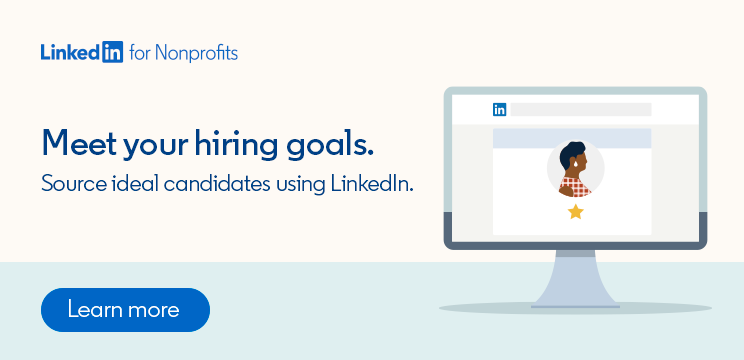
Nonprofit Interview Questions That Aren’t Useful, and How to Make Them Better
If you’ve worked at a nonprofit organization for a few years, you've probably heard or even asked these common nonprofit interview questions and know the type of lackluster answers they often inspire.
While none of these are “bad” interview questions, per se, their open-ended nature usually doesn’t lead to the kind of detailed answers that interviewers need to make a confident hiring decision.
So, how can hiring managers reimagine these nonprofit interview questions to get the information they need to make their next great hire? Let’s examine four common nonprofit interview questions and break down why they’re not as helpful as you might think — and what you can ask job candidates instead.
Rethinking Common Nonprofit Interview Questions
Question 1: What is your greatest strength?
This cliché is one of the most common, yet least helpful, interview questions. While some hiring managers purposely ask this open-ended prompt to see if interviewees can tie their answers to the specific job opportunity, some qualified candidates — particularly those less experienced at interviewing — might provide vague or irrelevant answers through no fault of their own. Why not offer a question that sets all interviewees up for success?
What to ask instead
“What is the most valuable skill that you will bring to this role, and how will you use it to improve our organization?”
This detailed nonprofit interview question guides candidates to offer specific examples of their top strengths and skills in the context of the open role. You’ll likely receive a great deal of insight into how the interviewee views themself in the role and how they envision success at your nonprofit — all of which can help inform a hiring decision. This prompt might also inspire important follow-up questions such as:
How will the candidate approach the job at hand?
What do they believe it takes to perform the role effectively?
How are they uniquely equipped to thrive in the role?
You can make this and other interview questions more specific and useful by leveraging LinkedIn Talent Solutions, which are available at a discount for eligible nonprofits. First, use LinkedIn Talent Insights to identify skills gaps in your organization and develop your updated list of interview questions. Then, leverage LinkedIn Recruiter to find and reach out to prospective hires that have the skills you need. Finally, during the interview, ask your qualified candidates about these skills explicitly, using your updated list of interview questions to guide the conversation.
Question 2: What is your greatest weakness?
Who enjoys speaking about their least attractive qualities? Nobody! And that’s the problem with this nonprofit interview question — you’ll never get a totally honest answer from your candidate. The best you can hope for when asking this question is that the interviewee is either very honest or they’ve read a lot of “how not to respond to interview questions” blog posts. If that’s the case, they’ll present a weakness semi-honestly as “something they know they have to work on.” But why not ask them about that in the first place?
What to ask instead
“What skills do you want to work on improving most if you work for our nonprofit?”
This question is a major upgrade because it can tell you a great deal about what the interviewee actually wants out of the role — and how seriously they’ll take working at your nonprofit.
Look for a thoughtful answer that demonstrates how the candidate hopes to grow within the role, the challenges they expect to face, and how they plan on tackling them.
Using LinkedIn Recruiter to vet your interviewees before the interview provides an opportunity to make this question even more valuable. You can also check your interviewees’ skills against the skills your role and organization needs via LinkedIn Talent Insights.
If you find any requisite skills missing from an interviewee’s profile, ask them about these skills during the interview. Give them an opportunity to tell you how they plan to build those specific skills on the job and beyond. LinkedIn’s discounted talent development solutions for nonprofits can help you create customized skill-building strategies, so a missing capability never needs to be a deal-breaker.

Question 3: Where do you see yourself in five years?
This question feels like a polite way of asking a much more direct — and uncomfortable — question: “Would you stay in this role long enough to be a good return on investment for our nonprofit?”
At the end of the day, the goal of the hiring process is to pair the right candidate with the right opportunity. As an employer, it’s fair to want clarity on a candidate's long-term professional goals and the role your nonprofit would play. So, why not just ask them about that?
What to ask instead
“How does this role help you further your career path?”
Most job seekers have their own vision for a big-picture career plan. Whether they stick with you as they pursue that journey will depend on two things: One, if the role they’re applying for can give them what they need right now, and two, if you’ll be able to support them as they grow and advance. A successful hire will feel that your organization is just as right for them as they are for you. Asking questions like this one is how you figure that out together.
When you’re discussing what the interviewee requires to move forward on their career path, introduce them to the resources you’ll be able to provide. Nonprofits across the world offer their employees access to LinkedIn Learning, which empowers professional development, helps fill skills gaps, and can foster a nonprofit culture of learning. You could even take the opportunity to begin designing a customized Learning Path with them right then and there. Not only will this make the interview feel more collaborative, but presenting these opportunities to the interviewee is a great way to get them excited about the prospect of working with you.
Question 4: Why do you want to work here?
There could be any number of “right” answers to this question, especially in the nonprofit world. Your interviewee will likely try to determine which you’re looking for and provide it, as opposed to opening up with an honest and meaningful response. An easy way to improve upon this question is to be more specific and tailor this prompt to reflect your organization and mission.
What to ask instead
“What about our mission resonates with you and why?”
Maybe it goes without saying, but the best nonprofit hires really care about what you’re doing and why. This top nonprofit interview question not only helps you understand your interviewee better, but can also allow them a chance to share what excites them about the opportunity and your organization.
Pay close attention to the candidate’s enthusiasm and body language while they answer this question. It’s a great opportunity for them to show they’ve done their research and truly understand your nonprofit’s mission. If they seem to genuinely believe in the good work you’re doing, it will show.
Learn more about discounted hiring and talent development solutions for nonprofits and how they can enhance your ability to find, engage, and hire the best employees for your team.

